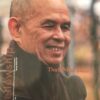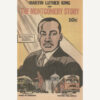By Matthew Arlyck
As we in this part of the world are entering the spring season, it seems like a good time to consider the cycles in our ongoing struggle to become Rev. Dr. Martin Luther King, Jr.’s beloved community. Just as Dr. King’s political strategy and moral concerns evolved and even shifted radically during his life, most of us involved in justice work have experienced growth in our consciousness. I’m personally starting to understand how movements work, and why they change.
I recently had the opportunity to reflect on my time with Occupy Wall Street (OWS), as the Fellowship of Reconciliation was creating a documentary film on the tenth anniversary of the Occupy movement. In September 2011, I was starting an internship with FOR, and through my involvement with a student group from Union Theological Seminary, called the Protest Chaplains, I became one of FOR’s on-the-ground respondents to the Occupy movement. When asked in the documentary about the most enduring takeaways from OWS, I shared about how Occupy radicalized me politically and how its “ending” taught me about the ebb and flow of mass movements.
Having now lived through and been part of several movement cycles – such as the War on Terror protests post-9/11, Occupy, and the Movement for Black Lives – one thing that I’ve noticed is the frustration and disappointment experienced by many people, especially those who are relatively new to justice work and organizing, when the initial energy and momentum that catapults a movement dissipates after the first few months. In meeting spaces that become increasingly smaller week after week, I’ve heard lamentations about how people have stopped coming out to protests and actions in the same numbers as they did just a month before.
Furthermore, in our age of social media there is no end to the judgments levied against the “virtue signaling” of people who move from sharing links for mutual aid, protests, and rallies to posting photos of their pets. (I remember that once the uprisings of 2020 became quiet, one friend on Instagram called out people for “cos-playing” activism – that friend has also now transitioned to mostly posting photos of his dog.) We aren’t always attuned to the reality that mass movements have rhythms that change over time; the question becomes, how can we live into those changing rhythms with intention and purpose?
In certain circles there is an increasing awareness that powerful, sustainable movement work must be more closely attuned to the natural world. There is a growing consciousness that for us to continue to organize for the future we need to be able to be aware that movements are always made up of a series of peaks and valleys, and that we need to be intentional about how we are operating in any given cycle. In his article “Movements and leaders have seasons — it’s important to know which one you are in” in Waging Nonviolence, the movement leader and trainer Carlos Saavedra talks about the need to think about cycles of leadership strategically by recognizing the “seasonality” of movements.
Saavedra describes four seasons of leadership: winter (rest, individual and collective reflection), spring (exploration, risk-taking and experimentation), summer (high energy and maximum activity) and fall (harvesting the “fruits” of organizing and activism, celebrating victories); movements and organizations need to go through these seasons just as individual leaders do. Saavedra suggests that we often don’t recognize this need because of the dominant culture’s focus on overproduction – we have internalized the message that to be effective we must always be doing more, working harder, never stopping.
Author and strategist adrienne maree brown also writes about how movement work benefits from an alignment with processes in nature; in her brilliant book Emergent Strategy brown talks about biomimicry as the way we learn to be in right relation to the difficult work of changing systems and changing ourselves. As brown tells us, “Instability has become a defining feature of our times”; adaptability has become a necessity for us to continue powerfully in this work. brown’s affectionate descriptions of how starlings fly in murmuration, fish shoal in schools, and bees swarm provide a guide for how we can agitate for change sustainably; starlings, fish and bees all move in harmony to one another towards a collective purpose at specific times of day or year. They have cyclical processes of productivity and rest – and the ways they move together allows for safety, communication, and support.
The organization Movement Generation, out of Oakland, California, which brown cites in her book, has crafted a statement about our need for adaptation by classifying the instability of our world into “shocks” and “slides.” The sudden shocks (acute climate events, uprisings, white nationalist violence) and the gradual slides (rising sea levels, rising unemployment, rising food and housing costs) require different responses and modes of being. I think that too often we as “movement people” respond to every crisis, whether shock or slide, in the same mode. We operate as if there is only one unchanging, never-ending season – what Saavedra calls the “eternal summer”.
In my current work as an organizer with POWER Interfaith, I’m finding that we are in a spring season in the movement, not just literally but organizationally. The Trump era created a climate of perpetual crisis response mode for POWER, with leaders organizing solidarity actions: at the Philadelphia airport following the so-called Muslim ban 2016; a “Philly Is Charlottesville” march in the wake of the Unite the Right rally in 2017; and a rapid response following the police murder of Walter Wallace in 2020, among others.
In 2021, our work turned inward, to evaluate how we would continue to organize powerfully now that we weren’t constantly putting out one dumpster fire after another. Here in Philadelphia, we’ve begun a citywide listening campaign with the recognition that during the pandemic our member congregations have become disconnected from one another and that we as an organization need to realign ourselves with what matters most to our people. We’re in a season of exploration and stretching ourselves, as we’ve committed to having 1,000 one-to-one conversations over the next three months.
Our default mode of eternal summer is not only harmful to the sustainability of the work – it also keeps us from being able to evaluate how change is happening. I think that the real test of a mass movement’s success is not in how many people perpetually show up to protests and marches, but in the ways that people become internally and collectively transformed by the experience. The enduring impact of a movement is less about the initial fireworks and more about how people begin the slower but ultimately more crucial work of organizing for systemic change.
If we can see movement work as a circle rather than a straight line, we can stop destroying ourselves and one another with judgments, burnout, and defeatism. When we can recognize that there is a time for things to end so that new life can emerge, we can begin to create the world that we all need in order not just to survive but to thrive.
Based in West Philadelphia, Rev. Matthew Arlyck is a faith community organizer with POWER Interfaith (Philadelphians Organized to Witness, Empower, and Rebuild).







